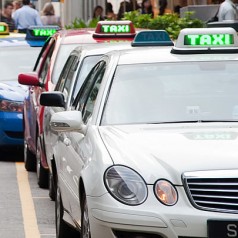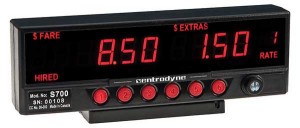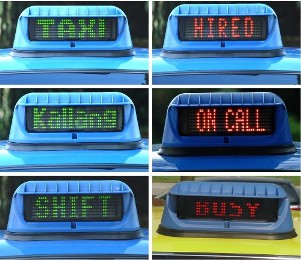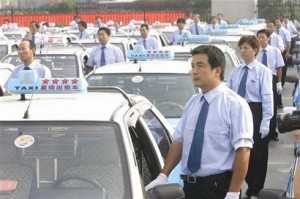Salaried taxi drivers in Singapore. Will it work?

I was reading an article in the newspapers about “Raising surcharges won’t make cabbies drive longer” and it set my mind thinking.
 The crux of the article is that raising surcharge will not make taxi drivers drive longer, simply because they may not be incentivised primarily by money. Taxi drivers in Singapore are typically self employed. That is, they rent a vehicle from the taxi company for a fixed cost. Then it’s up to them how hard working they want to be. Most of the time though, taxi drivers in Singapore tend to take a flexible approach to their work. If family matters come first, they will prioritise that.
The crux of the article is that raising surcharge will not make taxi drivers drive longer, simply because they may not be incentivised primarily by money. Taxi drivers in Singapore are typically self employed. That is, they rent a vehicle from the taxi company for a fixed cost. Then it’s up to them how hard working they want to be. Most of the time though, taxi drivers in Singapore tend to take a flexible approach to their work. If family matters come first, they will prioritise that.
Currently, there are already surcharges implemented through various means. Location based surcharge to encourage taxi drivers to go to a certain region/location. Time based surcharge to encourage drivers to be more active during peak hiring hours. Even then, these are implemented in various mechanisms such as peak hour surcharge, midnight surcharge, etc.
Often, when a taxi driver hits his profit target for the day, they will tend to take it easy. Maybe enjoy a coffee with some friends, or run personal errands with the taxi. In a personal/individual basis, it might make sense. But on a system basis, it degrades the reliability and service quality of the public transport system. Let’s not forget taxi is a form of public transport.
 The Land Transport Authority has recently mandated that 70% of a taxi fleet must cover 250km in a day. Even so, it is not likely to solve anything, but it adds more frustration into the system. 250km is simply 83km/h for 3 hours. I would imagine a typical active driver would cover more than that. But what it does is make ‘self employed’ people feel restricted on principle. So what next? A mandate of 500km? 750km?
The Land Transport Authority has recently mandated that 70% of a taxi fleet must cover 250km in a day. Even so, it is not likely to solve anything, but it adds more frustration into the system. 250km is simply 83km/h for 3 hours. I would imagine a typical active driver would cover more than that. But what it does is make ‘self employed’ people feel restricted on principle. So what next? A mandate of 500km? 750km?
In the article, the writer suggested having drivers with fixed salary and bonuses for good performances. Pondering about it, it actually sounds like a good idea!
Of course, the idea is not to dramatically change the entire taxi driver workforce into a fixed salary system. There will be too many pissed off people. But how about having it as a dual category system?
I used to be from stock broking, and trading representatives are generally separated into 2 groups, the remisiers and the dealers. There are many other sub groups and all, but I will just keep it simple.
The remisiers are self employed individuals who do not get any medical benefits, or cpf. They also have to put up a bankers guarantee to the brokerage house, as the remisiers are personally liable for their client’s trades. Essentially, the company lets them use a desk space, but in return, the remisier takes all the risks and rewards. Typically a remisier takes 40% of the total commission generated by them.
A dealer on the other hand, is employed by the brokerage house. They are usually paid a low salary of around $1.5k to 2.5k and they have typical employee benefits like annual leave, medical, cpf, etc. As such, they have to stick to fixed working hours and they usually report fairly often to their direct manager/director in charge. In some cases, dealers get clients from the various marketing channels employed by the brokerage house, such as roadshows, walk ins, and bank channels. In return, dealers get a much smaller cut, of around 25-30% (including the fixed salary), and this is typically quarterly or annually, as compared to monthly for remisiers.
So why not a dual category system for taxi drivers?
As I have said earlier, taxi is a form of public transportation. As such, LTA would want to maintain a certain level of service standards or availability. If we were to rely solely on self employed drivers, we would see occurrences where there are few taxis available at 9.30 am, simply because the peak surcharge have just ended, and a lot of taxi drivers value a good breakfast than another potential fare..
It’s already seen that the carrot (of higher surcharges) and the stick (of mandated mileage/time spent on the roads) are probably not the most effective tools. A paradigm shift such as that suggested by the Assoc Prof Chin might be something worth looking at.
 I envision a driver might earn something like $1.5k to 2.5k fixed salary, which a bonus component tied to the revenue generated on a monthly basis, and an annual bonus component tied to service excellence or something similar.
I envision a driver might earn something like $1.5k to 2.5k fixed salary, which a bonus component tied to the revenue generated on a monthly basis, and an annual bonus component tied to service excellence or something similar.
Do you think this might work?















I have also expanded this post into a part 2, to talk about the potential remuneration structure.. http://www.fergustan.net/viable-remuneration-structure-taxi-drivers-salaried-employee-route/